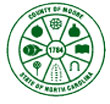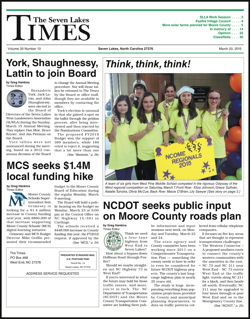 They had to ask twice, but representatives of Seven Lakes West ultimately got what they wanted: a dual-call system for 9-1-1 that will alert both Seven Lakes EMS and West End Fire and Rescue -- as well as Moore County EMS -- to 9-1-1 calls within the community.
They had to ask twice, but representatives of Seven Lakes West ultimately got what they wanted: a dual-call system for 9-1-1 that will alert both Seven Lakes EMS and West End Fire and Rescue -- as well as Moore County EMS -- to 9-1-1 calls within the community.
Many, if not all, of the Westsiders who attended the Tuesday, September 4 meeting of the Moore County Board of Commissioners to express their concern about emergency response left that meeting believing the Commissioners had approved just such a system. And at least one Commissioner -- Nick Picerno -- left believing the same.
But a close review of the actual motion approved by the Board -- by Clerk to the Board Laura Williams, by Deputy Public Safety Director Scot Brooks, and by The Times -- found that the Commissioners had approved something else: a recommendation by Brooks that, when a Moore County EMS unit is not available to take a call, the nearest volunteer ambulance would be dispatched.
Those different understandings of what transpired during the September 4 Board of Commissioners meeting surfaced during a county Emergency Services Advisory Committee [ESAC] meeting on Thursday, September 6, attended by a handful of Westsiders -- and by Picerno, the Commissioners' representative on the Committee.
After more than an hour of presentation and discussion around the issue, Picerno cut the Gordian's knot, insisting that the Commissioners intended to temporarily implement a dual-call system for Seven Lakes West. Public Safety Director Bryan Phillips said it was within the purview of ESAC to authorize the change, it was unanimously approved, and 9-1-1 Communications Manager Kris Sheffield implemented the new protocol before the meeting broke up.
What's Dual-Call?
Based on the ESAC action, any 9-1-1 call from Seven Lakes West will result in 9-1-1 operators sending a Moore County EMS Advanced Life Support paramedic ambulance to the scene -- plus, Basic Life Support personnel at Seven Lakes EMS and West End Fire and Rescue will also be paged to alert them to the incident, so that they can be ready to respond if needed.
Brooks explained in a presentation at the ESAC meeting that Moore County's emergency medical service is handled by two very different types of first responders:
• Professional paramedic crews manning Moore County EMS Advanced Life Support [ALS] ambulances, who have had at least 1,096 hours of training, can provide a wide range of medical services, and operate under the supervision of an emergency room physician at FirstHealth Moore Regional Hospital. The County has seven ALS units and is adding two more.
• Volunteer rescue squads manning Basic Life Support ambulances, who have had at least 169 hours of training and can provide basic medical services. Seven Lakes EMS and West End Fire and Rescue both fall into this category, as do rescue squads in Robbins, High Falls, Carthage, and Aberdeen.
The ALS paramedics are paid employees of the county, supported through a special ALS property tax levy. The volunteer rescue squads are also supported through a distribution of ALS funds, as well as through contributions and fundraising. Seven Lakes EMS also derives some funding by charging insurance companies and Medicare for patient transport; it is the only BLS-level squad in the county that bills insurance companies.
"We desperately need the volunteers," Brooks explained. "We try our best to support the volunteers, and give them a huge sum of money. We need them."
But Public Safety's goal, he added, is to respond to every call with what taxpayers have paid for: paramedic level service. So, every 9-1-1 call summons a Moore County EMS paramedic to the scene.
A County-Size Chess Board
Brooks explained that Public Safety handles 15,000 9-1-1 calls per year -- or more than 40 calls per day. As a result, it is common for one or more of the seven ALS paramedic teams to be occupied with a call. When that happens, the other ALS units are shifted from their usual posts to other staging areas in the county, in order to shorten their travel time if a call comes in.
"When we get down to three trucks available, we put one at Midway, one at Eastwood, and one at Pinecrest," Brooks explained.
When only one paramedic ambulance is not occupied with a call, that unit is positioned at Eastwood. When all the ALS trucks are on calls, the rescue squad units are asked to be ready to respond.
Brooks presented ESAC with a proposed revision of the current procedures, based on his understanding of the motion approved at the September 4 Commissioners' meeting. Under that scheme, when only three County ALS trucks are available, the BLS rescue squads would be notified. When only two county trucks are available, the pagers of BLS volunteers would be activated. When County EMS is down to one truck, BLS volunteers would be asked to go to their station and notify the 9-1-1 communications center when they are ready to respond to calls.
Brooks said his plan was a proposal that would have to be cleared with the BLS rescue squad chiefs.
Seven Lakes West: Not What We Asked For
But Brooks' plan was not the answer that Seven Lakes West was looking for.
"In a perfect world we would prefer to see the professional EMTs," Seven Lakes West Landowners Association [SLWLA] Secretary Jane Sessler told the committee. "That is the ambulance we would like to see . . . but you need to use your volunteers more efficiently. If you don't have enough paramedics, then you need to share the responsibility."
Sessler noted that the victim of a heart attack on Beacon Ridge Golf course was saved by volunteers, not by paramedics.
"A call came in this evening, and Seven Lakes EMS was not called," she said. "This is what we asked for the other night. A dual-call, so that the volunteers who live in the community can respond. It sounds like you have a contempt for the volunteers."
Former SLWLA President Ron Shepard added: "In April, the call system for Seven Lakes was changed and Seven Lakes wasn't notified. And a pickup truck shows up instead of an ambulance. The real problem is that you broke up Seven Lakes and eliminated the dual call."
Public Safety began a process in April of redrawing the rescue squad district lines in Seven Lakes West, which has always been split between the Seven Lakes and West End Fire Districts. However, prior to the change, rescue calls for all of Seven Lakes West were routed to Seven Lakes EMS rather than West End Fire and Rescue. In April, the lines for rescue were made congruent with those for fire. And, while the change was the subject of meetings and negotiations between Public Safety and the two rescue squads, neither the public nor the SLWLA was notified about the change.
Fire Marshall Ken Skipper argued that the change made sense, because, using the back gate, West End Fire and Rescue is closer than Seven Lakes EMS to the east side of Seven Lakes West. Brooks added that the West End squad is larger, and responds to one hundred percent of the calls it receives, which is not the case for Seven Lakes EMS.
Erik Stromberg, an ESAC member and, until recently, assistant chief at West End, noted that he lives on Callis Circle and that other Westsiders volunteer with West End Fire and Rescue.
Though the details were not clear, conversation among Phillips, Brooks, Skipper, and Seven Lakes EMS member Chuck Ridenour during the meeting made clear that the relationship between Seven Lakes EMS and West End Fire and Rescue is rocky at best. Phillips suggested that the rescue district lines in Seven Lakes West were redrawn in April after an argument erupted between the two BLS squads when both responded to a call.
Dual Call a Temporary Fix
After considerable back-and-forth, ESAC Chairman Otis Ritter said he left the September 4 Board meeting under the impression that Seven Lakes EMS would be automatically dispatched to all calls in Seven Lakes West. Both Picerno and the Westsiders present seconded that impression.
Picerno then offered a motion to implement a dual-call system, in which Moore County EMS, Seven Lakes EMS, and West End Fire and Rescue will all be notified when a call comes in from Seven Lakes West. That was unanimously approved by the committee, and immediately implemented in the 9-1-1 system.
However, it is a temporary fix -- designed, in Picerno's words, to "take the emotion out of the situation," so that the community, ESAC, and the Commissioners can focus on facts.
In earlier action, the committee approved a $42,250 bid from Volunteer Fireman's Insurance Service for a comprehensive "Fire Services Agency Evaluation and Emergency Services Master Plan Study" that will "evaluate the current staffing, operations, resource deployment and to make recommendations for current and future operations that will consider anticipated continued growth over the next 10 -15 years within Moore County."
That study will also examine and make recommendations for fire, rescue, and EMS district response areas. If the contract is awarded by the Commissioners, the study is expected to begin in October and deliver a final report in February 2013, in time for recommendations to be incorporated in the county's FY 2013-2014 budget.
And that report will likely once again raise the issue of who is called, when a Westsider calls 9-1-1.
